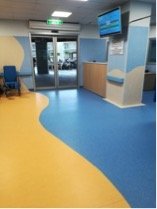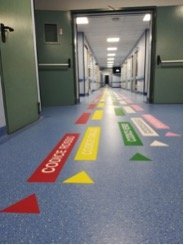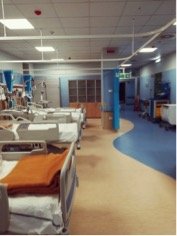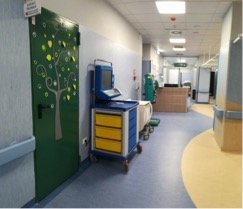- G. Longo
- Original Article
A new model of Emergency Department: person-focused/patient-centered care and a strategic design of spaces
- 2/2018-Luglio
- ISSN 2532-1285
- https://doi.org/10.23832/ITJEM.2018.017
G. Longo2, Matarazzo2, C. Maiorino2, G. Perito2, G. Cozzolino3, R. Della Monica3, B. Di Gennaro3, G. Vitolo3, F. Molino3, G. Forzano3, M. V. Carlino1,2, A. Sforza1,2, G. Castellano1,2, P. Ieranò1,2, S. Russo1,2, A. Costanzo1,2, A. Sommese1,2, J. Niro1,2, S. Grasso1,2, A. Corcione1,2, F. Chiumiento1,2, M. de Giovanni, M. Guarino1,2
- Emergency Department, C.T.O., Naples
- A.O.R.N. dei Colli, Naples
- Architects of A.O.R.N. dei Colli, Naples

Corresponding author:
Mario Guarino, MD
Emergency Department, C.T.O., Naples
Keywords
medical humanities, emergency department, person-focused care, patient-centered care.
Both patient-centered and person-focused care are important (1). In this direction, central aims for our health system are to deliver the best quality of care to our patients, organize work throughstandardized protocols, use human, material and financial resources adequately, encourage empathyfor our patients’ feelings and ensure patient-centered communicationmodel.
Our Emergency Department (ED) includes two entrances to triage area: one for walking patients (through the waiting room) and another for ambulance patients. ED patients’ satisfaction is strictly linked to the role of the nurses, namely the first interface between patients and hospital services (2) and, in this direction, there will be two triage nurses (certified for this role) for each turn. They will establish, through the “Quick-look”, the priority of admittance, deciding the order in which patients will receive treatment. Each patient will receive an identifying bar code bracelet with the attributed color code. Furthermore, triage nurses task will be to identify patients for the “fast track system” and “pink codeemergency system”. Triage areaand waiting roomare characterized by soft colors and curved lines (Figure 1); thesestrategic design elements allow stress relief. In the waiting room, patients and their family could take advantage of smarthphone USB sockets, a library and a television showing images of training sessions in simulated emergency settings of our team members or a video about C.T.O. history. Furthermore, in the waiting room, a volunteers group will entertain patients and their family ensuring stress relief.
The entrance, from the triage areato the emergency visit area, is characterized by a transparent sliding door equipped with stretcher height sensors, allowing, if necessary, a quick patient access to the acute treatment area. Moreover, the transparent sliding door represents a strategic design element because it ensures patients’ privacy and it decreases the distrust sentiment usually generated by physical barriers.
The emergency visit area is organized in rooms, the first of which is the end-stage-room, where palliative care is delivered for the relief of patients’ symptoms and to support family in bereavement. This room, if necessary, will be used as our isolation roomto prevent the transmission of air-borne diseases.
Nowadays, while the majority of physicians still receive limited training in communication skills (3), instead all our team members (physicians and nurses) will develop patient-centered communication skills. Moving in this direction, the white/pink room(the second room of the visit area) will be used as “bad news communication room”, since it is sometimes unavoidable in the ED to deliver bad news to the patient and/or his/her family (4). The third room is for the fast track system and for procedural sedationand analgesia. Underling that all paths (pink, white, green, yellow and red) are identifiable by vertical and horizontal signage (Figure 2), there are two rooms for green code, one for yellow codeand then the resuscitation room.This area is characterized by innovative emergencycarts that are organized according to the “A.B.C.D.E.” approach, drugs wardrobes with wheels to speed up their use and a wide window to decrease burnout risk for physicians and nurses.
Moreover, there is the team-working room, where every day at twelve ò clock there will be a briefing about the ED observation unit patients and a journal club about recent emergency medicine literature. Soft colors and curved lines reappears in theED observation unit (Figure 3)where, similarly to the waiting room and the corridors, there is a background 432 Hz–music from a preloaded playlist. In fact recent studies showed thatmusic is an easy and useful way to decreaseseverity of pain and anxiety of visitors in the emergency department waiting area (5). In the ED observation unit there are four bedswith hemodynamic monitors. In this area patients will be also involved in a narrative medicine project by a group of psychologists; patients will be asked to write something about their experience in our ED and their writings will be attached to the hope’s door in theED observation unit (Figure 4).
In conclusion we hope that our Emergency Department mightprovide to our patients the highest quality care, giving importance to patients preferences and values and offering them emotional support and physical comfort.
Figure 1. Triage area
Figure 2. Horizontal signage
Figure 3. Emergency Department observation unit
Figure 4. Hope’s door
References
- Is Patient-Centered Care the Same As Person-Focused Care? Starfield, Barbara. Perm J. 2011 Spring; 15(2): 63–69. .
- Factors Affecting Patient Satisfaction With Emergency Department Care: An Italian Rural Hospital. G. Messina, F. Vencia, S. Mecheroni, S. Dionisi, L. Baragatti, N. Nante. Glob J. Health Sci. 2015 Jul; 7(4): 30–39.
- Developing physician communication skills for patient-centered care. Levinson W., Lesser CS., Epstein RM. Health Aff (Millwood). 2010 Jul;29(7):1310-8.
- Breaking bad news education for emergency medicine residents: A novel training module using simulation with the SPIKES protocol. Inchoel Park, Amit Gupta, Kaivon Mandani, Laura Haubner and Brad Peckler. J Emerg Trauma Shock. 2010 Oct-Dec; 3(4): 385–388. .
- Emergency department waiting room stress: can music or aromatherapy improve anxiety scores? Holm L., Fitzmaurice L. Pediatr Emerg Care. 2008 Dec;24(12):836-8.
- PATIENT-CENTRED CARE: IMPROVING QUALITY AND SAFETY BY FOCUSING CARE ON PATIENTS AND CONSUMERS. Healthcare, Australian Commision on Safety and Quality in September 2010.





